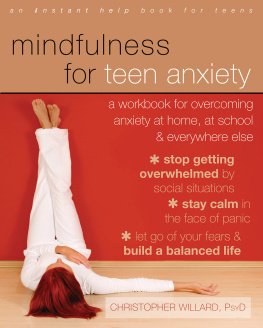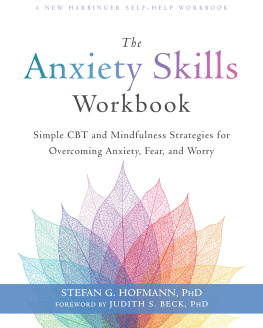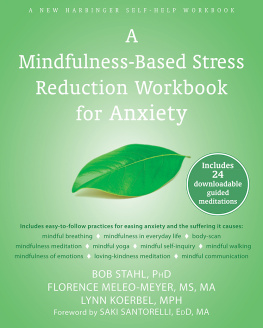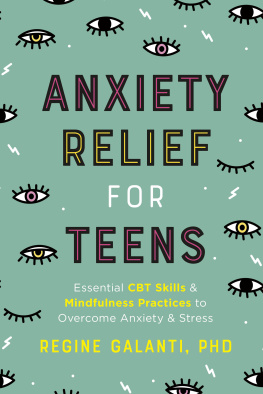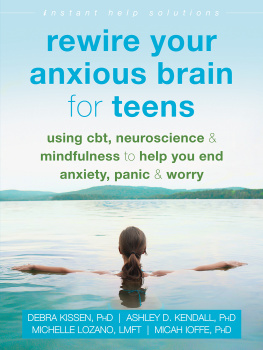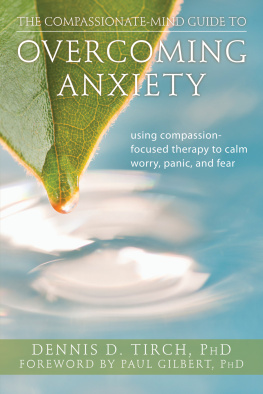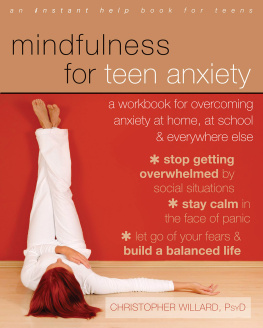Christopher Willard, PsyD, is a psychologist and learning specialist in the Boston area who specializes in working with adolescents and young adults in his private practice at Tufts University. He regularly consults schools, clinics, and other institutions, and teaches workshops across the US and around the world. His website can be found at www.drchristopherwillard.com.

If, like all teens, you sometimes feel anxious, or if, like many teens, you suffer from intense anxiety, reading a few pages in this book will help you feel calmer. Every chapter is like a reassuring talk with a good friend. This book gives you real, practical, simple skills for easing anxiety, being more relaxed and kinder to yourself, and ultimately living a happier life.
Amy Saltzman, MD, author of A Still Quiet Place

Publishers Note
This publication is designed to provide accurate and authoritative information in regard to the subject matter covered. It is sold with the understanding that the publisher is not engaged in rendering psychological, financial, legal, or other professional services. If expert assistance or counseling is needed, the services of a competent professional should be sought.
Thoughts on Parade adapted from Thought Parade Exercise in ACCEPTANCE AND MINDFULNESS TREATMENTS FOR CHILDREN AND ADOLESCENTS by Laurie A. Greco and Steven C. Hayes. Copyright 2008 by Laurie A. Greco and Steven C. Hayes. Used by permission of New Harbinger Publications.
The Guest House from THE ESSENTIAL RUMI by Jalal al-Din Rumi, translated by Coleman Barks. Translation copyright 1997 by Coleman Barks. Used by permission of Coleman Barks.
Go Among Trees copyright 1998 by Wendell Berry from A TIMBERED CHOIR. Used by permission of Counterpoint.
Ten Thousand Flowers by Wu Men [p. 47, 4l.] from THE ENLIGHTENED HEART: AN ANTHOLOGY OF SACRED POETRY, EDITED by Stephen Mitchell. Copyright 1989 by Stephen Mitchell. Reprinted by permission of HarperCollins Publishers.
Distributed in Canada by Raincoast Books
Copyright 2014 by Christopher Willard
Instant Help Books An Imprint of New Harbinger Publications, Inc.
5674 Shattuck Avenue
Oakland, CA 94609
www.newharbinger.com
Cover design by Amy Shoup; Edited by Karen Schader; Acquired by Jess OBrien
All Rights Reserved
Library of Congress Cataloging-in-Publication Data
Willard, Christopher (Psychologist)
Mindfulness for teen anxiety : a workbook for overcoming anxiety at home, at school, and everywhere else / Christopher Willard, PsyD.
pages cm
Summary: Its hard enough being a teen without having to worry about panic attacks, chronic worry, and feelings of isolation. In Mindfulness for Teen Anxiety, a psychologist offers teen readers proven-effective, mindfulness-based practices to help them cope with their anxiety, identify common triggers (such as dating or school performance), learn valuable time-management skills, and feel calm at home, at school, and with friends-- Provided by publisher.
Audience: Age 14-18.
ISBN 978-1-60882-910-1 (paperback) -- ISBN 978-1-60882-911-8 (pdf e-book) -- ISBN 978-1-60882-912-5 (epub) 1. Anxiety in adolescence--Juvenile literature. 2. Mind and body in adolescence--Juvenile literature. I. Title.
BF724.3.A57W55 2014
155.51246--dc23
2014016269
Introduction
In my years of working with young adults from many different backgrounds and situations, Ive found that it is the smartest and most creative ones who suffer the most from anxiety. I believe that anxiety is the result of a smart, creative mind run amok. Think about itif you are suffering from anxiety, you can probably think of dozens of reasons why your class presentation will go wrong, why the prom will be a disaster, or why your parents will be disappointed in you. The minds of most other people dont generate nearly as many ideas, either positive or anxious.
The good news is that you dont have to be afraid of your own mind any longer. With some help and some hard work, and by using some of the practices in this book, you can get that amazing mind of yours back to working for you, not against you.
One of the best adages Ive heard essentially says that our thoughts can be our greatest servants or our worst masters. This adage rings very true for me as someone who has seen and helped hundreds if not thousands of people overcome anxiety disorders. When our minds are working for us, they can skillfully produce the answer to a math problem, process visual information from dozens of sources while we are driving at sixty miles per hour, or instruct our bodies in the thousands of muscle movements required just to dribble a basketball. But when our brains are misfiring, they can send us the wrong messagesthat its time to panic, that something terrible is about to happen to us or to someone we loveand thats when things start to get really scary in our minds.
Its not entirely clear why some of us have anxiety; researchers still dont completely agree. For a long time, debates raged about nature versus nurture; youve probably even discussed this in your science classes. What we understand today is that anxiety is probably the result of both. You may have genes that make you more vulnerable to anxiety, and you may have experienced situations or stressors that are activating your anxiety.
Whatever the source of your anxiety, this book offers ways to deal with it in the moment, along with practices to help keep it at bay, and discusses some lifestyle changes for reducing stress that may be making your anxiety worse. It includes written exercises and also asks questions, with lines for writing down your responses. Some of these might feel too personal to write in this book, so feel free to write your answers elsewhere, or not at all; if you dont write, at least give the questions some thought.
Many of the tools have been adapted from very ancient practices, and others come from modern psychotherapy techniques. For example, the Body Scan () was developed by Michele McDonald.
If you feel like you need motivation, it can help to go through this book with a friend, relative, or therapist. And although you can skip around and just read the parts that feel most important to you, you will get the most out of the book by doing the whole thing start to finish, and regularly practicing what youve learned along the way.
Learning to manage day-to-day anxiety is not going to be an easy path, but it is a path that a lot of other teens and adults have followed successfully, and so can you.
About Anxiety
Some people have a genetic predisposition to anxiety; because of the genes they inherited, they are more likely to develop anxiety disorders than other people. But all of us experience anxiety at some point in our lives, and with good reason. We need a protective alarm system to alert us to danger and help us stay safe.
Having anxiety is like having an oversensitive alarm system that goes off at all the wrong times, keeping us from getting anything done. It can be downright embarrassing in the wrong situation. Or worse, it can end up putting us in more danger because we are so focused on the false alarm that we miss the signals of real danger.
It can be helpful to know what causes your anxiety, but sometimes it feels more important just to know what to do about it. That is the main goal of this book: to give you practical tools you can use for the toughest anxiety-provoking situations. It may feel hard to be young and facing anxiety, but the positive side is that once you work through your anxiety, which you can, you will be able to help yourself and others for the rest of your life.

